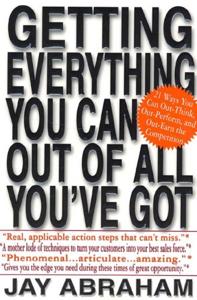
Want to learn the ideas in Getting Everything You Can Out of All You’ve Got better than ever? Read the world’s #1 book summary of Getting Everything You Can Out of All You’ve Got by Jay Abraham here.
Read a brief 1-Page Summary or watch video summaries curated by our expert team. Note: this book guide is not affiliated with or endorsed by the publisher or author, and we always encourage you to purchase and read the full book.
Video Summaries of Getting Everything You Can Out of All You’ve Got
We’ve scoured the Internet for the very best videos on Getting Everything You Can Out of All You’ve Got, from high-quality videos summaries to interviews or commentary by Jay Abraham.
1-Page Summary of Getting Everything You Can Out of All You’ve Got
Overview
There are only three ways to grow your business:To increase the number of clients, to increase the amount they buy from you (sales), and to increase their frequency of buying. These strategies have been shown to work.
Many companies and people don’t use all the strategies because they either don’t know about them or choose not to use them. However, there are no good reasons for that when you can combine various marketing strategies such as advertising and referrals.
This book is about 21 strategies that help salespeople get ahead. One of those strategies is maximizing results and multiplying them to beat the competition.
Maximize What You Have
The first few strategies will help you use what you already have. You can use your existing client base and the services that you currently provide to boost your business.
A flight plan
Every business is in the sales business. The key to being successful is recognizing that you have clients, even if they are internal ones such as your supervisors, bosses and shareholders.
Companies should focus on developing long-term relationships with their clients instead of focusing on short-term gains. A client is someone who relies on another person or company for help, while a customer is simply someone who buys something from you. You want to build these long-lasting relationships by understanding your customers’ needs and providing them with the solutions they’re looking for, even if it means losing money in the short term.
Breakthrough ideas
All industries have standard ways of doing business. Realtors work on a commission basis, retail outlets sell a certain set of products. These strategies are successful, which is why everyone uses them, but because everyone uses them these strategies can only be so successful. Breakthrough ideas that are radically different from the norm will help you succeed in an industry where others just follow the pack and do what they’re told to do.
One way to get new ideas is to look outside your field. Dave Linger, the founder of Re/Max, had a problem with his realtors leaving for other companies because they were keeping all their commissions and paying for office space out of that money. So he told them about how barbers could solve this same problem by only charging rent on chairs and letting barbers keep all tips and fees. This was an unusual idea in the real estate industry but it worked well enough that clients (barbers) liked it.
Breakthrough ideas are important for any part of business. Take operations, marketing, distribution, technology and sales systems. Break down each area into subsections and brainstorm 20 to 30 potential breakthrough opportunities for all the subsections by using ideas from other industries as well as from the past.
Assess current business strengths
You can’t innovate if you don’t know what your strengths are. A 50-question checklist will help you figure out how to use your strengths, where they came from and how to serve your clients better. The checklist starts with a historical analysis of why you started the business or career path that you’re on now, what motivated you, and what progress has been made since then. It also asks about the unique selling proposition for your company, how much it costs to recruit new clients and retain current ones, as well as marketing successes in the past and current challenges. Consider this a diagnostic checkup for identifying weaknesses in order to strengthen them later on.
Calculate the lifetime value of your client
Long-term clients are more profitable than short-term ones. They spend more money and buy products from you over a longer time period. Therefore, when thinking about how to acquire new customers, it’s important to think about the value of those customers in the long run.





